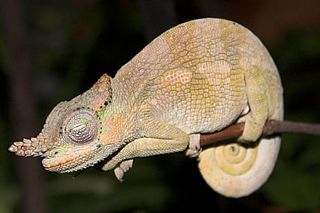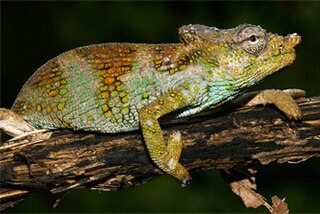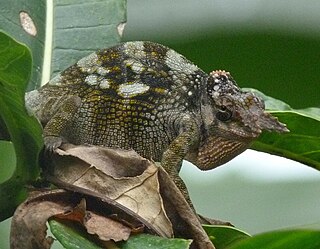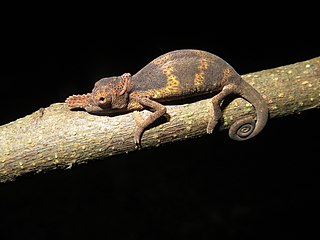
Fischer's chameleon, also known commonly as the Nguru blade-horned chameleon and the Nguru two-horned chameleon, is a species of chameleon, a lizard in the family Chamaeleonidae. The species is endemic to Tanzania.

The strange-horned chameleon, also known as Rwenzori plate-nosed chameleon or single welded-horn chameleon, is a species of chameleon. It is native to the rainforests of the Ruwenzori Mountains of western Uganda and eastern Democratic Republic of the Congo.

Kinyongia is a chameleon genus recently established for several plesiomorphic species found in forest and woodland in Kenya, Tanzania, Uganda, Rwanda, and far eastern DR Congo. All except K. adolfifriderici and K. tavetana are restricted to highlands, and many have very small geographic ranges. In most, at least the males have horns or knobs on their noses. They had been placed into the genus Bradypodion for some time. It has recently been pointed out that the ending to the specific epithet in several of the below listed species should be modified to match the feminine genus name.

The Udzungwa Mountains National Park is a Tanzanian national park in Kilolo District of Iringa Region and Kilombero District of Morogoro Region. The park is mostly located in Kilolo District. It has a size of 1,990 km2. The habitats contained within the national park include tropical rainforest, mountain forest, miombo woodland, grassland and steppe. There is a vertical height range of 250–2,576 metres, which incorporates the Udzungwa Mountains part of the Eastern Arc Mountains. There are more than 400 bird species, 2,500 plant species and 6 primate species. It has the second largest biodiversity of a national park in Africa.

Kinyongia vanheygeni, the Poroto single-horned chameleon or Van Heygen's chameleon, is a species of chameleon, a lizard in the family Chamaeleonidae.

The West Usambara two-horned chameleon or West Usambara blade-horned chameleon is a species of chameleon endemic to the West Usambara Mountains of Tanzania. Until 2008, it was generally confused with Fischer's chameleon, which is not found in the Usambara Mountains. None of its close relatives occur in the same range as K. multituberculata, but K. matschiei and K. vosseleri are restricted to the East Usambaras.

Kinyongia tavetana, the Kilimanjaro two-horned chameleon or Kilimanjaro blade-horned chameleon, is a species of chameleon in the genus Kinyongia. It is native to forests, woodlands, well-wooded gardens and plantations in the highlands of southern Kenya and northern Tanzania. Its type locality is Mount Kilimanjaro, but it is also known from Chyulu Hills and Mount Meru to the Pare Mountains.

The sharp-nosed chameleon is a chameleon native to the Uluguru and Udzungwa Mountains of Tanzania, where it inhabits forests, woodlands and plantations at an altitude of 1,400–1,900 m (4,600–6,200 ft) above sea level.
Kinyongia carpenteri, commonly called Carpenter's chameleon or the helmeted chameleon, is a species of chameleon, a lizard in the family Chamaeleonidae. The species is native to central Africa.

Kinyongia tenuis, also known as the Usambara soft-horned chameleon, Usambara flap-nosed chameleon and Matschie's dwarf chameleon, is a fairly small species of chameleon from Kenya and Tanzania.

Kinyongia matschiei, common name giant monkey-tailed east Usambara two-horned chameleon, giant east Usambara blade-horned chameleon, and Matschie's two-horned chameleon, is a species of chameleon from the East Usambara Mountains in Tanzania. It was formerly confused with K. fischeri, which is not found in the range of K. matschiei.
The Rugege Highlands forest chameleon is a species of chameleon. It is endemic to the Rugege Highlands of Burundi, but likely occurs in the Nyungwe Forest in the immediately adjacent Rwanda. The Burundian records are from or near the Kibira National Park. It was formerly considered to be included in Kinyongia adolfifriderici.

Kinyongia boehmei, the Taita blade-horned chameleon, Böhme's two-horned chameleon and Dwarf fischer's chameleon, is species of chameleon, a lizard in the family Chamaeleonidae, found only in the Taita Hills of southeastern Kenya. It is the smallest species in the East African "two-horned chameleon" group and until 2008 it was generally considered a part of K. tavetana.

Mount Kenya sentinel chameleon, or Mount Kenya hornless chameleon, is a species of chameleons endemic to Kenya. It is known from Mount Kenya, Nyambeni Hills, and Aberdare Range.
Kinyongia gyrolepis is a species of kinyongia chameleons first described in 2012, and the sister species to the Kinyongia adolfifridericichameleon. It is more commonly known as the circular-scaled chameleon.
Kinyongia itombwensis is a species of chameleons endemic to the eastern Democratic Republic of the Congo. Its common name is Itombwe forest chameleon.
Kinyongia tolleyae is a species of chameleons endemic to Uganda. Its common name is Tolley's forest chameleon.

Kinyongia uluguruensis is a species of chameleon, also known as the Uluguru two-horned chameleon or Uluguru two-horned chamaeleon. It is endemic to highland forests in the Uluguru Mountains of Tanzania.

Kinyongia uthmoelleri, known commonly as the Hanang hornless chameleon, Müller's leaf chameleon, and Uthmöller's chameleon, is species of lizard in the family Chamaeleonidae. The species is endemic to Tanzania.

Kinyongia vosseleri, also known commonly as the Usambara two-horned chameleon and Vosseler's blade-horned chameleon, is an endangered species of lizard in the family Chamaeleonidae. The species is endemic to Tanzania.















